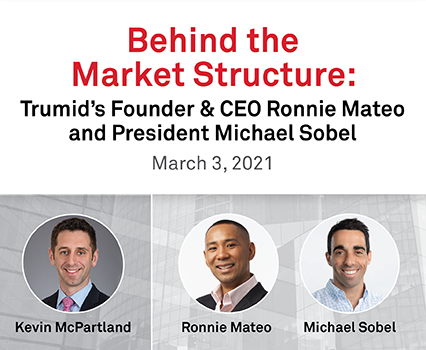Electronic bond trading is more about delivering workflows than protocol
2020 marked an inflection point in the electronic trading of corporate bonds, as it proved its value and resilience in ways it never had before. With the market poised for further growth and innovation, Kevin McPartland, Head of Market Structure and Technology Research at Greenwich Associates, spoke to Trumid’s Founder & CEO Ronnie Mateo and President Michael Sobel. The Wall Street veterans-turned-fintech entrepreneurs spoke on the evolution of the fixed-income market, Trumid’s journey so far, and their plans to capture growth, going forward.
Following are edited highlights of the conversation:
Kevin McPartland (KM): It's been seven years since you founded Trumid. Can you tell us how you started the company and reached where you are today?
Ronnie Mateo (RM): Let me share some personal background first. I had ‘grown up’ at Solomon Brothers for 12 years. I was running a group that managed credit derivatives global indices, and Michael Sobel was one of the traders I worked with.
After that, I created and ran a brokerage. Interestingly, large buy-side institutions began asking for access to that liquidity. That’s against the spirit of the interdealer market. So, a light bulb went on. I’m a big sneakerhead and I was on eBay, trying to buy a pair of Jordans from a kid in Canada and Air Force 1s from someone in Indonesia. I was like, ‘I can do this on my phone in the consumer space, but corporate bonds are still transacted the way they were in 1950.’
Around 2013–2014, I started having conversations with people on creating an all-to-all platform for the buy and sell side, which got shot down institutionally. So, I decided to take a shot at it.
The thought wasn’t let’s build great technology and run with that, it was about finding the right people in the market, and who had the credibility and relationships, given that 250 institutions represent 80% of the flows in corporate bonds.
Michael Sobel (MS): Our shared vision from the beginning was to create a marketplace. At the time, I don't think any of us had heard of the term ‘network effect.’ We set out to create a marketplace for efficient trading, information dissemination and execution between corporate bond market participants. Many twists and turns later, that remains the vision. The more we grow and activate that network and give users more tools to interact, the more attractive the platform becomes.
We focused on round lots early on because we thought that was ripest for electronification. We thought we could build a differentiated product because we had spent so many years in the seat. As it turns out, we have been able to continually deliver built-for-purpose products.
We also focused obsessively on building the client network early on. That's harder to build and takes longer than the technology, so, that focus was key.
KM: You made a sharp shift from markets to fintech. How did that happen, and what was the result?
RM: Like with any successful network story, the start is a grind of hand-to-hand combat. Our space is not like Instagram that can get three million followers in three weeks. These are epically long cycles from a B2B space. So, we needed that hard-core credibility that comes with humans.
Once you get past that moat, the momentum builds and becomes sticky. But, building that truly engaged community takes real manpower. It’s about leveraging those relationships to build great products, which bring in more relationships, which creates a cycle and the network starts working. Once that starts, you just try to get a little better every day and build credibility and trustworthiness with users.
That's how it starts, and all of a sudden, you're able to recruit great technologists who build great products—and one plus one equals three. The whole process has been very organic. The key is having collaborative relationships with our clients, and the only way to deliver on their trust is by being able to imagine, design, build, and operate products that meet their needs.
So, the nimble, client-focused product and technology portion of the offering goes hand-in-hand with the human part to deliver the value proposition.
KM: E-trading for corporate bonds encompasses so many different technologies and trading mechanisms. What are your views on how the markets should evolve, going forward?
MS: Our asset class is idiosyncratic. That’s why electronification of global credit will take a different shape than other asset classes, and the bucketing will be a little different.
We think it's really important to build for purpose, which means that the right answers are going to blend across the traditional taxonomy. For us, it is about creating workflows that drive transparency and efficiency for users [through] a spectrum of valuable tools. It's about workflows more than it is about protocols.
KM: Trumid recently announced plans to foray into the Asian markets. What’s next on the growth agenda?
MS: We have created a diverse and engaged client base, a technology stack that is truly nimble, and we have credibility in turning our fixed-income expertise and client relationships into products. Those are scalable things, so it makes sense to expand our footprint. At the same time, we are not experts in all products and geographies, so partnerships are valuable to us.
In Asia, we are working to deploy a lot of what we're currently doing. We are a few months into a Latin-centric emerging markets effort. And we're thinking about enhancement and expansion of our existing protocols.
So, geographies, products and protocols are on the expansion horizon—and we are turning the wheels on all of those vectors.
RM: To repeat our grand vision, we will become the most fluid, dependable electronic connection for large institutions to communicate, transact and own data streams across products and across the globe.

